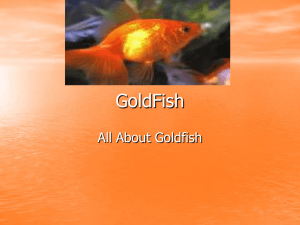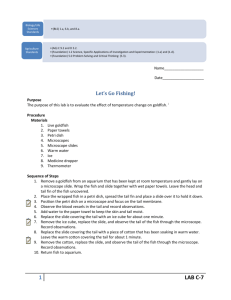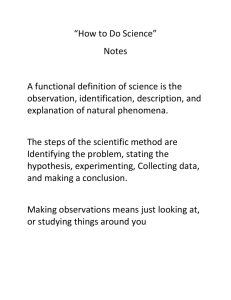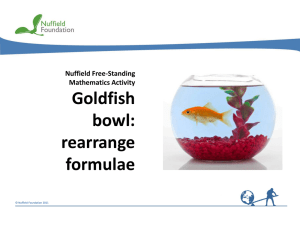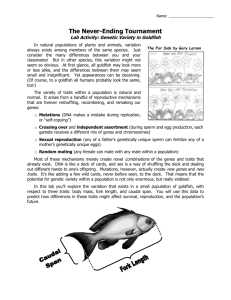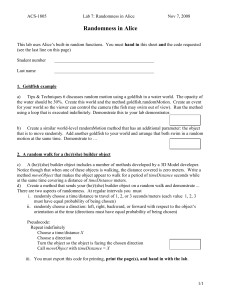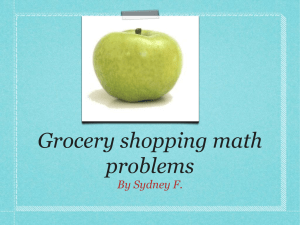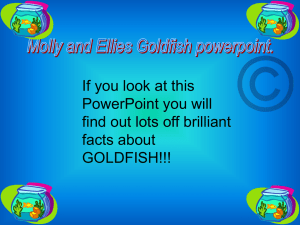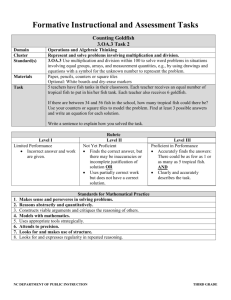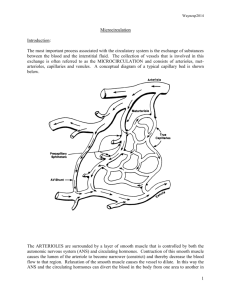Goldfish Varieties Poster
advertisement
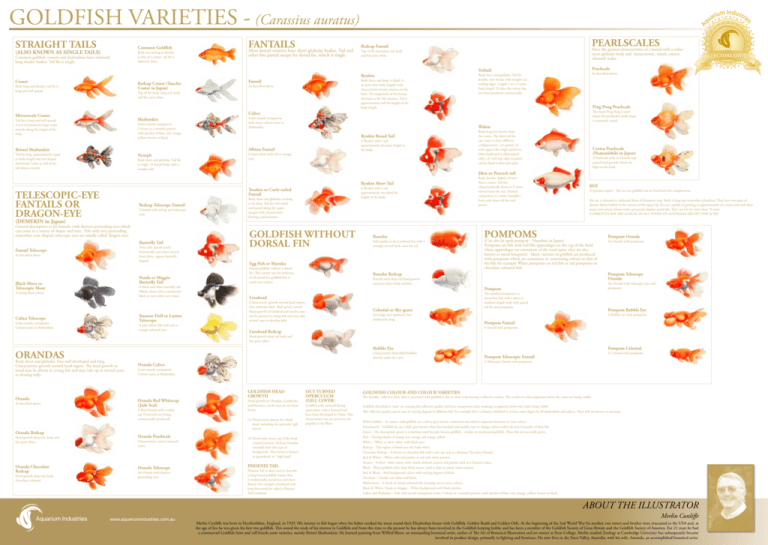
STRAIGHT TAILS Common Goldfish (ALSO KNOWN AS SINGLE TAILS) Body not as long or slender as that of a comet, tail fin is relatively short. Common goldfish, comets and shubunkins have relatively long slender bodies. Tail fin is single. FANTAILS Most fantail varieties have short globular bodies. Tail and other fins paired except for dorsal fin, which is single. Aq PEARLSCALES Have the general characteristics of a fantail with a softer Redcap Fantail Top of the head deep red, body and fins pure white. more globular body and characteristic, raised, convex (domed) scales. Comet Redcap Comet (Tancho Comet in Japan) Body long and slender, tail fin is long and well spread. Body short and deep (a depth ¾ or more than body length) with characteristic hump contour on the back. The magnitude of the hump increases as the fish matures. Tail is approximately half the length of the body length. Fantail As described above. Top of the head, deep red, body and fins pure white. As described above. Body short and globular. Tail fin double, very broad, with straight-cut trailing edges. Length 1 to 1.5 times body length. To date this variety has not been produced commercially. Ping Pong Pearlscale The name Ping Pong is used where the pearlscale’s body shape is extremely round. Calico Mirrorscale Comet Shubunkin Tail fin is long and well spread. A row of prominent large scales extends along the length of the body. Scales mainly transparent. Colours in a mottled pattern with patches of blue, red, orange, yellow, brown or black. Scales mainly transparent with many colours same as Shubunkin. Wakin Ryukin Broad Tail A Ryukin with a tail approximately the same length as the body. Albino Fantail Bristol Shubunkin Tail fin long, approximately equal to body length and not draped downward. Lobes at end of the tail almost circular. Nymph Body short and globular. Tail fin is single. (A fantail body with a straight tail). Colour white with red or orange eyes. A Ryukin with a tail approximately one third the length of the body. Tosakin or Curly-tailed Fantail Redcap Telescope Fantail A fantail with redcap and telescopic eyes. (DEMEKIN in Japan) General description as for fantails, with distinct protruding eyes which can come in a variety of shapes and sizes. Fish with very protruding, somewhat cone shaped, telescopic eyes are usually called ‘dragon eyes’. Butterfly Tail Twin tails, spread nearly horizontally and when viewed from above, appear butterfly shaped. Fantail Telescope As described above. Panda or Magpie Butterfly Tail Black Moor or Telescopic Moor A black and white butterfly tail (Black colour often transitional – likely to turn white over time). A strong black colour. Siamese Doll or Lutino Telescope Calico Telescope Scales mainly transparent. Colours same as shubunkins. A pale yellow fish with red or orange coloured eyes. Body long but heavier than the comet. The short tail fin can come in three different configurations; (1) paired, (2) with upper lobe single and lower lobes duplicated (called tripodtails), (3) with top edge of paired tail fin fused (called web-tails). Crown Pearlscale (Hamanishiki in Japan) A Pearlscale with an Oranda type paired head growth which sits high on the head. Jikin or Peacock tail Ryukin Short Tail TELESCOPIC-EYE FANTAILS OR DRAGON-EYE Body short and globular, tending to be deep. Tail fin web-tailed and joined along the upper margin with characteristic flowing conformation. GOLDFISH WITHOUT DORSAL FIN Ranchu Fish similar to the Lionhead but with a strongly curved back, near the tail. Egg Fish or Maruko Fantail goldfish without a dorsal fin (This variety was the forbearer of all dorsal-less goldfish but is rarely seen today). Body slender, slightly shorter than a comet. Tail fins characteristically form an X when viewed from the rear. Desired colouration is a white (metallic) body with deep red fins and points. KOI (Cyprinus carpio) – Koi are not goldfish but are listed here for completeness Koi are a coloured or cultivated form of European carp. Body is long and somewhat cylindrical. They have two pairs of distinct fleshy barbels in the corners of the upper lip. Koi are capable of growing to approximately one metre and with their many and varied colours make spectacular display, pond fish. They can live for more than 70 years. CURRENTLY KOI ARE ILLEGAL IN ALL STATES OF AUSTRALIA EXCEPT NSW & WA POMPOMS (Can also be spelt pompon – Hanafusa in Japan) Pompom Oranda Pompoms are fish with ball like appendages on the top of the head (these appendages are extensions of the nasal septa, they are also known as narial bouquets). Many varieties of goldfish are produced with pompoms which are sometimes in contrasting colours to that of the fish for example White pompoms on red fish or red pompoms on chocolate coloured fish. Ranchu Redcap Pompom Telescope Oranda Ranchu with deep red head growth and pure white body and fins. An Oranda with telescopic eyes and pompoms. Pompom Lionhead Characteristic growth around head region. Fins relatively short. Back gently curved. Head growth of lionhead and ranchu may not be present in young fish and may take several years to develop fully. Celestial or Sky-gazer Eyes large and upturned, fins moderately long. An Oranda with pompoms. The standard pompom is a dorsal-less fish with a short to medium length body with paired tail fin and pompoms. Pompom Bubble Eye A Bubble eye with pompoms. Pompom Fantail A Fantail with pompoms. Lionhead Redcap Head growth deep red body and fins pure white. ORANDAS Body short and globular. Fins well developed and long. Bubble Eye Characteristic fluid filled bubbles directly under the eyes. Characteristic growth around head region. The head growth or hood may be absent in young fish and may take up to several years to develop fully. Oranda As described above. Oranda Calico A Red Oranda with a white cap (Currently not being commercially produced). Oranda Redcap Head growth deep red, body and fins pure white. Oranda Pearlscale Oranda Chocolate Redcap Oranda Telescope Head growth deep red, body chocolate coloured. Pompom Celestial A Celestial with pompoms. Pompom Telescopic Fantail A Telescopic Fantail with pompoms. Scales mainly transparent. Colours same as Shubunkin. Oranda Red Whitecap (Jade Seal) Characteristic convex (domed) scales. An Oranda with distinct protruding eyes. GOLDFISH HEAD GROWTH Head growth on Orandas, Lionheads, and Ranchus, can be seen in two basic forms. (1) H ood covers almost the whole head, including the opercular (gill cover). (2) H ood only covers top of the head (cranial portion). Redcap Orandas normally have this type of headgrowth. This variety is known as ‘goosehead’ or ‘ high head’. PHOENIX TAIL Phoenix Tail is often used to describe a long finned goldfish variety that is traditionally, dorsal-less and short finned. For example a lionhead with long fins would be called a Phoenix Tail Lionhead. OUT TURNED OPERCULUM (GILL COVER) Goldfish with outward flaring operculum, with a forward curl, have been developed in China. This characteristic has not proved to be popular in the West. GOLDFISH COLOUR AND COLOUR VARIETIES The metallic, reflective shine that is associated with goldfish is due to their scales having a reflective surface. This results in colour pigments below the scales not being visible. Goldfish described as ‘matt’ are missing this reflective quality and have transparent scales resulting in pigments below the scales being visible. This reflective quality can be seen in varying degrees in different fish. For example this is a feature exhibited to at least some degree by all shubunkins and calicos. These fish are known as nacreous. Wild Goldfish – In nature, wild goldfish are a silvery grey brown, sometimes described in Japanese literature as ‘iron colour’. Uncoloured – Goldfish fry are a dull, grey-brown when first hatched and usually start to change colour within the first 6 months of their life. Green – The description ‘green’ is sometimes used for pale bronze goldfish – similar to uncoloured goldfish. These fish are not really green. Red – Varying shades of orange red, orange and orange yellow. White – White or silver white, with black eyes. Redcap – Top region, of head area red, body white. Chocolate Redcap – A brown or chocolate fish with a red cap such as a Redcap Chocolate Oranda. Red & White – White with red patches or red with white patches. Sarassa – A silver- white colour with, clearly defined, intense red patches such as a Sarassa Comet. Black – Black goldfish other than black moors, tend to fade in colour when indoors. Red & Black – Red background colour with varying degrees of black. Tricolour – Usually red, white and black. Multicolour – A batch of mixed coloured fish showing two or more colours. Black & White, Panda or Magpie – White background with black patches. Calico and Shubukin – Fish with mostly transparent scales. Colours in a mottled pattern, with patches of blue, red, orange, yellow, brown or black. ABOUT THE ILLUSTRATOR www.aquariumindustries.com.au CTORS EDITION COLLE Pearlscale Veiltail Ryukin s GOLDFISH VARIETIES - (Carassius auratus) m Industr u i r ie ua Merlin Cunliffe Merlin Cunliffe was born in Hertfordshire, England, in 1935. His interest in fish began when his father stocked the moat round their Elizabethan house with Goldfish, Golden Rudd and Golden Orfe. At the beginning of the 2nd World War his mother, two sisters and brother were evacuated to the USA and, at the age of five he was given his first two goldfish. This sowed the seeds of his interest in Goldfish and from this time to the present he has always been involved in the Goldfish keeping hobby and has been a member of the Goldfish Society of Great Britain and the Goldfish Society of America. For 21 years he had a commercial Goldfish farm and still breeds some varieties, mainly Bristol Shubunkins. He learned painting from Wilfrid Blunt, an outstanding botanical artist, author of The Art of Botanical Illustration and art master at Eton College. Merlin studied Zoology at Cambridge University but subsequently became involved in product design, primarily in lighting and furniture. He now lives in the Yarra Valley, Australia, with his wife, Amanda, an accomplished botanical artist.
